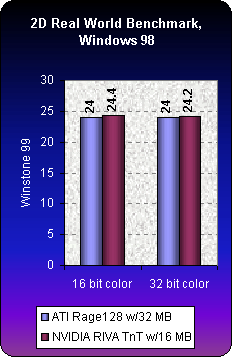First Look at ATI's Rage 128
2D Performance
ATI's Rage Pro was already doing pretty fine in 2D, but now Rage 128 has to fight against some real kick-ass 2D performers, 3Dfx Voodoo Banshee and NVIDIA RIVA TNT. Most of you won't bother too much about this, since 2D performance seems to have almost reached the theoretical maximum.
OEMs still like to have this information though, simply for the almighty marketing. You know that I detest Winbench's 2D tests. They make you believe that one card is double as fast as another, but once you are running an application you don't notice a difference.
I prefer running real world tests as e.g. the new Winstone99, and the results show that TNT has got a slight edge over Rage 128 in 16 as well as 32 bit color mode. The quality of Rage 128's RAMDAC seems to be fine, but I haven't done any in depth testing of the 2D quality yet.
I came across some strange display errors once in a while though, proving that the driver deserves the name 'beta' well. Choosing the refresh rate is also a bit difficult, but ATI is aware of the problem with the DDC and it's supposed to be fixed 'soon'.
The tests ran on a PII 504 (overclocked 450 MHz version) system, with 128 MB SDRAM, Asus P2B-LS motherboard, IBM DGVS 09U ultra wide SCSI hard drive.

ATI's Rage Pro was already doing pretty fine in 2D, but now Rage 128 has to fight against some real kick-ass 2D performers, 3Dfx Voodoo Banshee and NVIDIA RIVA TNT. Most of you won't bother too much about this, since 2D performance seems to have almost reached the theoretical maximum.
OEMs still like to have this information though, simply for the almighty marketing. You know that I detest Winbench's 2D tests. They make you believe that one card is double as fast as another, but once you are running an application you don't notice a difference.
Stay on the Cutting Edge
Join the experts who read Tom's Hardware for the inside track on enthusiast PC tech news — and have for over 25 years. We'll send breaking news and in-depth reviews of CPUs, GPUs, AI, maker hardware and more straight to your inbox.
I prefer running real world tests as e.g. the new Winstone99, and the results show that TNT has got a slight edge over Rage 128 in 16 as well as 32 bit color mode. The quality of Rage 128's RAMDAC seems to be fine, but I haven't done any in depth testing of the 2D quality yet.
I came across some strange display errors once in a while though, proving that the driver deserves the name 'beta' well. Choosing the refresh rate is also a bit difficult, but ATI is aware of the problem with the DDC and it's supposed to be fixed 'soon'.
The tests ran on a PII 504 (overclocked 450 MHz version) system, with 128 MB SDRAM, Asus P2B-LS motherboard, IBM DGVS 09U ultra wide SCSI hard drive.
Game Engine Performance Booster
Before we get into the 3D benchmarks I have to explain a few things. On the search for the highest 3D performance ATI is adding a little tool program called 'Game Engine Performance Booster', which can improve performance in Direct3D or OpenGL based games.
You can choose between no frame rate acceleration, Direct3D acceleration or OpenGL acceleration. This little tool wouldn't be too bad, if it wouldn't require a reboot each time you switch. It also screws up Super7 systems based on the VIA Apollo MVP3 chipset, once you try switching to OpenGL acceleration. I may be allowed to ask what this tool is supposed to be about though. NVIDIA doesn't need an acceleration switch for different games and I am pretty happy about that. I consider it as a nuisance if I have to reboot to make sure that my 3D accelerator works as fast as it can, it's also dangerous forgetting to switch back to 'no acceleration', because the 'booster' says itself:
'When you finished playing, turn off frame rate acceleration before running other applications or you will experience system instability. The proper acceleration for each type of game must be selected or system instability will occur. '
Well, 'system instability' is one of my favorites. I love putting my system into this condition. My second advice to ATI is getting rid of this 'booster' before the cards will ship.

Current page: 2D Performance
Prev Page From 100 Down To 90 MHz Core Clock Sounding Familiar? Next Page 3D PerformanceMost Popular

